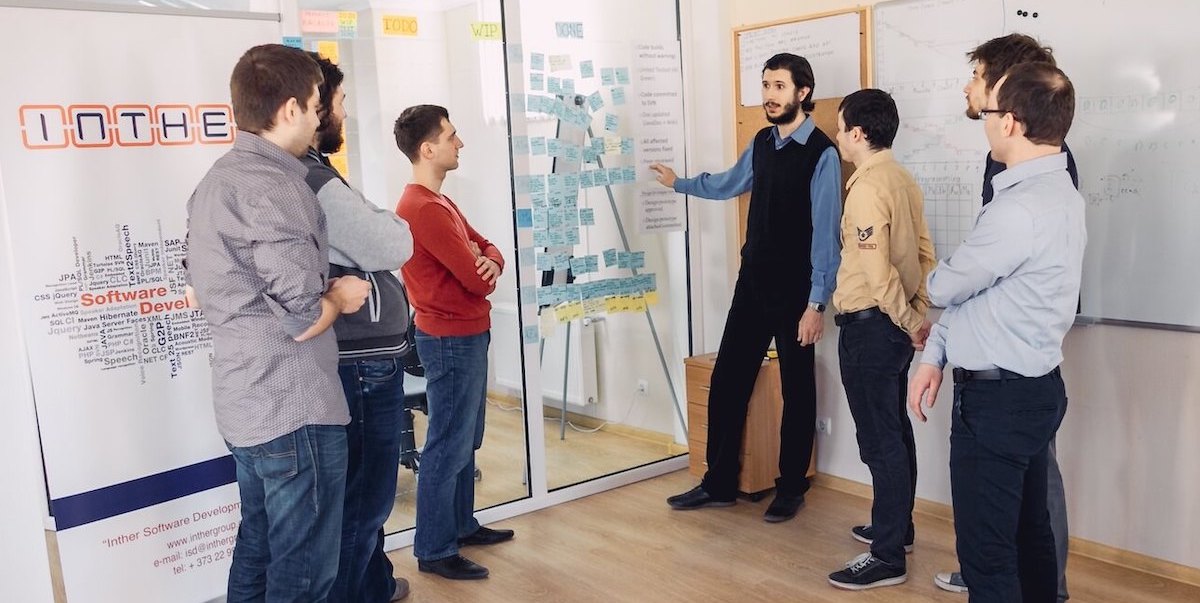If you’ve ever been on a development team, chances are you have attended stand-up meetings. Also called daily scrum and daily stand-up, these meetings allow teams to briefly communicate their individual and collective progress, helping them stay responsive.
And while stand-up meetings used to be practiced mostly by software development teams, they are now adopted by all kinds of agile teams due to their effectiveness in rendering information within a short span.
To hold a stand-up meeting effectively, you need a good grasp of the principles and best practices, which is why the post is created. Let’s dive right in!
What is a stand-up meeting?
Stand-up meetings, typically held by Agile or Scrum teams, are short meetings where team members update their progress and challenges on tasks and projects.
As the name suggests, in stand-up meetings, all attendees are required to participate while on their feet to ensure that the meetings are kept short and straight to the point due to the discomfort of standing.
The rule is, however, not applicable in virtual stand-up meetings that are common among remote and hybrid teams. And though they have the same purpose, subject matter, and approach as in-person standup calls, they are typically held over video conferencing software. Therefore, while attendees are not required to stand, other rules of standup meetings, including keeping the meeting short, apply.
Daily standups are often held early in the work day (that’s why it’s also called morning standups) so that they can serve as a guide on what the team would focus on for the rest of the day. Three main questions are discussed in a daily standup are:
The meeting revolves around these questions closely and does not delve into the resolution of those problems. But instead, tables them for a separate discussion.
The purpose of stand-up meetings
On the surface, stand-up meetings seem only to intend for teams to conduct quick status checks on their tasks and projects. But in agile, they serve a much broader purpose, which includes:
Because the entire conversation during stand-up meetings is framed around what team members have achieved and what is left undone, the team gets a clear picture of if they’re on track to complete the sprint goal.
Also, teams are aligned on the project progress and potential risks after the discussion.
Stand-up meetings allow teams to flag blockers and define what needs to be done daily.
This has proven valuable for several organizations and has provided the information necessary to access workload distribution within teams. According to Jannie Oosthuizen, the President of MSD Japan, agile ceremonies (which include stand-up meetings) provide a “regular pulse check of team health and workload” for the company.
Team members are required to provide an account of their tasks and progress during meetings. This compels them to take ownership and responsibility for their work and to stay accountable to other team members.
Detecting obstacles as soon as they occur is often crucial to promptly and successfully resolving them. Usually, when obstacles are left untended, they end up becoming much bigger problems.
Stand-up meetings allow teams to quickly identify potential blockers or problems and address them so that the team’s work can run smoothly.
From the preceding, it is clear that daily stand-up meetings are an essential agile ceremony for teams looking to work and deliver projects more efficiently.
Capture every detail with AI meeting notes
Notta offers the most integrated AI meeting notes, summaries, and action items so nothing gets missed.
How to run a stand-up meeting?
There are two typical approaches to running standing meetings:
1. Round Robin

The Round Robin approach has its origins in Scrum.
Here, the team stands roughly in a circle around the scrum or Kanban board, and everyone provides their update by answering the three main questions of stand-ups in a predetermined order.
The emphasis of this approach is more on individual team members and their contributions to the team’s task or project.
Pros
It is suitable for teams trying to improve individual and team productivity, participation, and accountability.
Team members can freely communicate their blockers and get help.
The simplicity of the approach makes it beginner-friendly for new agile teams.
It keeps the conversation focused on the three stand-up questions.
Cons
Team members might not focus while others are speaking if they are mentally preparing for their turn.
The emphasis is often on individual work rather than quantifying the project's progress.
Team members could derail the conversation and drone on if not firmly guided.
2. Walking the board

“Manage the work; let people self-organize around it.”
A team using this approach would typically stand next to a Kanban board with cards representing pending tasks. The facilitator then selects a card for the team to discuss until all the tasks or projects are exhausted. It is common practice to choose cards that are closest to Done.
This approach aims to optimize the team’s process and minimize the time spent on tasks at every stage. So, more attention is given to the timely completion of pending projects.
Pros
The discussion is usually straight to the point, with fewer chances of derailing.
It promotes teamwork because it focuses more on collective progress than individual responsibility.
Teams can pay more attention to the details of every task and project
Cons
More complicated than Round Robin and often requires some studying to execute it effectively.
Avoiding responsibility and accountability is easier with this method
The outcome of the meeting does not always translate into clear action plans for individual team members
Summarily, the key distinguisher between these two approaches is that while Round Robin focuses on people (or team members) and is easier to operate, Walking the Board focuses on tasks and is more suitable for experienced teams.
7 Best practices to run a productive stand-up meeting
Pause and think about what an effective and successful stand-up meeting looks like.

This exercise is important because you and your team are responsible for determining what success is to you.
However, as a general rule, an effective stand-up meeting should:
Be short and highly focused
Help teams spotlight and overcome challenges
Keep teams aligned
End with a clear direction on how to proceed
Once you are clear on your vision for a successful stand-up meeting, you can hold one using the best practices discussed below.
1. Discuss the meeting goals and rules with your team
Doing this is especially important if you are holding stand-up meetings for the first time or looking to optimize your team’s current practice. Making these decisions before proceeding with recurring stand-up meetings will help to save time on planning and making decisions for subsequent meetings.
Some of the things you need to agree on include the following:
To reach fair and effective decisions on the above, your team must consider the team’s overarching goals and deliverables, team size, the organization’s culture, and favored agile practice. Also, if team members are distributed across different time zones, you should settle for a time that is convenient for everyone.
It is worth noting that you do not have to remain bound to these decisions. You can conduct reviews as a team to determine what works and make changes where necessary.
2. Appoint a facilitator
A daily standup also needs a facilitator to moderate the meeting and keep it organized. The facilitator is typically in charge of timing the status updates so they remain brief, preparing the agenda, collating meeting notes, moderating the conversation during the meeting, and updating the Kanban board.
The role is often assigned to the Scrum master if your team uses Scrum or the project manager if you adopt the project management methodology.
In teams with no such roles, the team lead or most senior team member is usually saddled with this responsibility. In any case, it is important to consider the competence and workload of the team member assigned as the facilitator. This way, you can guarantee that the facilitator is efficient and not unduly burdened.
3. Stick to a routine
Commitment and consistency are key components of effective standups.
The routine could include determining the time and place, having the stand-up as a recurring meeting, assigning fixed meeting roles, and a predetermined speaking order.
Daily standup meetings should happen at the same time every day at a fixed place (for example, my team has morning stand ups at 10 am each day in the office).
Having a routine makes it easy for attendees to know what to expect and take it as a priority. And practicing this consistency would make running the meeting more efficient.
The team leader, however, evaluates the effectiveness of your routine from time to time. Feel free to switch it up if it becomes boring, monotonous, or unproductive.
4. Break large teams into smaller groups
The ideal size of a daily standup is less than 10 people.
You cannot realistically hold a standup meeting within the ideal timeframe if you have a large team. For example, if your team has 20 members and you have carved out 15 minutes for the entire meeting, holding an effective meeting is impossible. It would also be counter-productive to ask attendees to rush through their reports.
Therefore, dividing large teams into smaller groups would be a more productive approach. That way, the members can even further reduce their meeting time.
When dividing team members into groups, it is advisable to consider what they have in common such as tasks, responsibilities, or priorities. In effect, it would be better to group team members who work closely or whose assignments depend on one another.
This tip is especially useful for growing teams. Learning to adapt your process to your team’s needs is crucial for running effective stand-up meetings.
5. Keep the conversation short and focused
Ideally, stand-up meetings should be at most 15 minutes and the conversation should revolve exclusively around the project.
Therefore, you must implement measures like a countdown timer to ensure strict compliance with the timeframe. A guide for how each team member’s report should be delivered could help achieve the purpose.
You should also avoid deviating from the meeting subject.
However, despite your best efforts, some important topics that require timely discussion might arise during the meeting. And as tempting as it might be to break the flow of the meeting to accommodate them, it is not advisable.
Instead, you can note the topics and schedule another meeting if necessary or use your team’s preferred instant messaging channel to discuss them. What is important is that they are addressed - but not within the stand-up meeting.
6. Use project management software
Stand-up meetings could be a little tricky for remote teams. This is because of the absence of some key components of in-person stand-ups such as standing up and gathering around.
However, the good news is that teams can hold successful remote stand-ups with a video conferencing tool and project management software.
You can create your Kanban Board on task management tools like Jira, ClIckUp, Asana, etc., making visualizing and monitoring pending tasks easy.
Pro Tip: Ensure the software you select can be integrated into your workflow. This will make syncing data and working with the different tools seamless.
7. Make your meetings fun
No one likes boring meetings and because stand-up meetings are frequent and have the same ritual, they can easily begin to feel monotonous.
You can avoid this by introducing fun elements into the meetings such as icebreakers, quick games, light jokes, or even music. This gives attendees something to look forward to during meetings.
Also, even though you should strive to make the meetings focused, you must ensure that you do not suck the fun out of it by being overbearing or excessively strict.
Run effective team meetings with Notta
Notta AI meeting assistant records, transcribes, and summarizes meetings so everyone can stay engaged without missing important details.
What are some stand-up meeting mistakes to avoid?
If your stand-up meetings are not going the way you envisioned or are unproductive, chances are that you are making more or one of these common mistakes:
Sitting down
“There’s a reason why stand-up meetings are conducted standing up; it’s because they’re meant to be quick and to the point.” - Jarret Austin, Bankruptcy Canada
Sitting down for stand-up meetings puts the purpose and practice of the meeting at risk because team members can easily become comfortable and fully immersed in the meeting to the point that they lose track of time.
This can prolong the meeting beyond the ideal timeframe and create room for other mistakes we will subsequently identify.
Requiring or permitting team members to give detailed reports
Detailed reports should not be required or allowed during stand-up calls.
Never, ever turn meetings into status reports. The emphasis of stand-up meetings is to help team members align on their work by providing one another with a snapshot of progress and challenges in pending tasks. Any additional detail or review would derail the meeting. This is by far the most significant mistake you can make.
Discussing irrelevant topics
This is one of the biggest time-wasters in stand-up meetings that unnecessarily prolong the session.
The conversation must remain on the specified talking points and must be discussed as framed. So, ensure you avoid small talk, side comments, problem-solving, giving feedback, or any other discussion that takes the meeting off its tangent.
Starting the meeting late
Tardiness should never be encouraged or tolerated (except with good reason) during meetings. When team members arrive late, the meeting is likely to start late. This makes it likely to overshoot the timeframe carved out for the meeting.
The project manager or scrum master also has a responsibility to always start the meeting as scheduled. Failing to do this will only encourage team members to arrive late.
Free stand-up meeting template for agile teams
A good stand-up meeting template should serve as an easy guide on how to structure discussions during the meeting. It will save you the time and effort of creating one.
This daily stand-up meeting template maps out a clear flow for virtual or in-person meetings. You can apply it directly or edit it to suit your team’s goals.
Project Updates
Give each team member time to answer the below questions:
Next Steps
Assign action items to the specific member with an estimated completion date.
FAQs about stand-up meetings
Why is it called a stand-up meeting?
It is called a stand-up meeting because participants are required to stand throughout the meeting duration. This is to keep the meeting short and focused.
What are the three questions asked at a stand-up meeting?
The three questions asked at a stand-up meeting are:
How long should a stand-up last?
Stand-up meetings should ideally last between 5 and 15 minutes, depending on the team size and volume of tasks the team is charged with.
How to run an asynchronous standup meeting?
Even though most of our discussion in this article has focused on synchronous stand-up meetings, it is important to note that stand-ups can also be held asynchronously without real-time communication.
They are usually done over the team’s preferred instant messaging platform and are better suited to remote teams. If you are ready to give asynchronous stand-up meetings a go, here is a step-by-step guide to getting you started:
Step 1: Discuss your team priorities during a synchronous team meeting at the start of the week.
Step 2: Decide on a platform and format for team members to answer the three stand-up questions. This could be via Slack, email, or any other instant messaging channel of your choice. You must, however, ensure that the responses are accessible to all team members.
Step 3: Require them to send their responses daily within an agreed timeframe. The beginning of the work day is ideal.
Step 4: Extract action points from the responses submitted and assign them to team members accordingly.
It is important to note that asynchronous stand-ups follow the same agenda as synchronous meetings. You can simply use a regular stand-up meeting agenda to guide the session.



